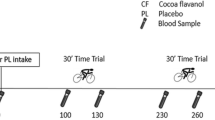Abstract
Andean Indians have used coca leaves (Erythroxylon coca and related species) for centuries to enhance physical performance. The benefits and disadvantages of using coca leaf have been a subject of many political debates. The aim of this study was to investigate the effects of chewing coca leaves on biochemical and physiological parameters. Cutaneous microdialysis catheters were used to estimate systemic biochemical changes. We subjected 10 healthy adult males (local residents) in Cajamarca (Peru, altitude 2700 m) to a standardised exercise routine on a stationary cycle ergometer. The blood pressure, oxygen saturation (digital), pulse, VO2 max and ECG (Holter monitor) were recorded before the exercise. Cutaneous microdialysis catheters were introduced in the forearm. The subjects were given to chew 8 g of coca leaves with a small amount of lime. They were then placed on the cycle ergometer for 20 min. Blood pressure, oxygen saturation, pulse, ECG and VO2 max were recorded. Pyruvate, glucose, lactate, glycerol and glutamate levels were estimated. Oxygen saturation, blood pressure, and pulse rate did not show any significant changes between the two groups. Glucose levels showed hyperglycaemic response. Glycerol, Lactate and Pyruvate increased. Glutamate remained unchanged. Similar changes were not seen in the controls. These results suggest that coca leaves have blocked the glycolytic pathway of glucose oxidation resulting in accumulation of glucose and pyruvate. The energy requirement for exercise is being met with beta-oxidation of fatty acids. The glycerol released was also getting accumulated since its pathway for oxidation was blocked. These experimental findings suggest that chewing coca leaves is beneficial during exercise and that the effects are felt over a prolonged period of sustained physical activity.
Similar content being viewed by others
References
Spielvogel H, Caceres E, Koubi H, Sempore B, Sauvain M, Favier R. Effects of coca chewing on metabolic and hormonal changes during graded incremental exercises to maximum. J Appl Physiol. 1996;80:643–9.
Favier R, Caceres E, Koubi H, Sempore B, Sauvain M, Spielvogel H. Effects of coca chewing on hormonal and metabolic responses during prolonged sub maximal exercises. J Appl Physiol. 1996;80:650–5.
Hanna JM. The effects of coca chewing on exercise in the Quechua of Peru. Hum Biol. 1971;42:1–11.
Carter, Mann. Chapter II, Coca leaves: scientific aspects. In: Gumuciol JH, editor, Cocaine the legend. La Paz, Bolivia: Hisbol; 1995.
Lanza G. Coca prohibited, Chapter I. LaPaz, Bolivia: Hisbol; 1995.
Paracelsus. Theosophy 1938 March;26(5):197–204.
Nagabhushana S, Venkatesh T, Casikar V. The olfactory system regulates acute mountain sickness. J Stress Physiol Biochem. 2009;5:4–15.
Anderson CD. Cutaneous microdialysis: is it worth the sweat? J Invest Dermatol. 2006;126(6):1207–9.
Muller M. Microdialysis has wide applicability for in vivo measurements. BMJ. 2002;324:588–91.
Pechar G, McArdle W, Katch F, Magel J, DeLuca J. Specificity of cardiorespiratory adaptation to bicycle and treadmill training. J Appl Physiol. 1974;36(6):753–6.
Grant R. Energy systems used during exercise: online article. Articlesbase 2008; posted online Dec 3rd.
Turcotte LP. Role of fats in exercise: types and quality. Clin Sports Med. 1999;18(3):485–98.
Kumar R, Grover SK, Shyam R, Divekar HM, Gupta AK, Srivastava KK. Enhanced thermo genesis in rats by a composite Indian Herbal preparation—I and its mechanism of action. J Altern Complement Med. 2007;5(3):245–51.
Graver SK, Divekar HM, Kumar R, Pashwa ML, Bharadwaj SK, Gupta AK, Srivastava KK. Experimental evaluation of a composite Indian herbal preparation—II (CIHIPII) as an adaptogen and its mechanism of action. Pharm Biol. 1995;33:148–54.
Author information
Authors and Affiliations
Corresponding author
Rights and permissions
About this article
Cite this article
Casikar, V., Mujica, E., Mongelli, M. et al. Does Chewing Coca Leaves Influence Physiology at High Altitude?. Indian J Clin Biochem 25, 311–314 (2010). https://doi.org/10.1007/s12291-010-0059-1
Received:
Accepted:
Published:
Issue Date:
DOI: https://doi.org/10.1007/s12291-010-0059-1




